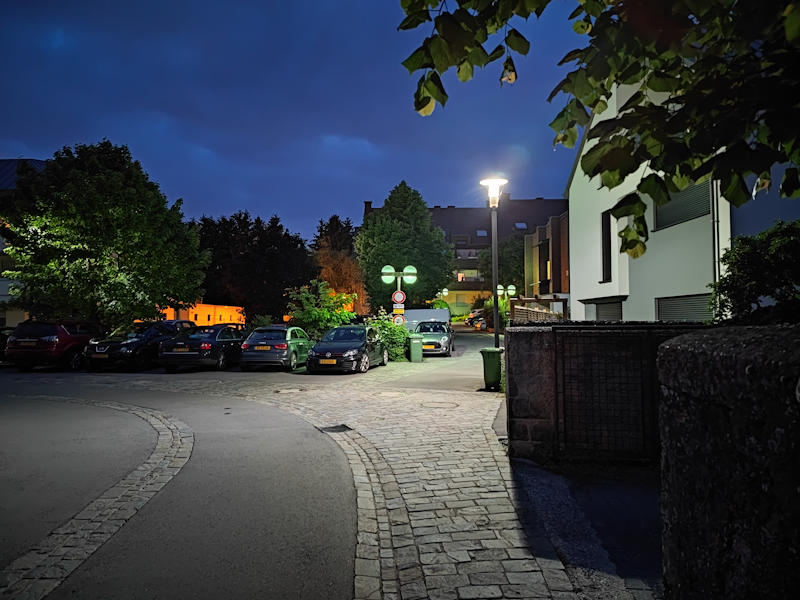The Xiaomi Mi 11 Ultra Review: Big and Fast, but Inefficient
by Andrei Frumusanu on July 20, 2021 9:00 AM EST- Posted in
- Mobile
- Smartphones
- Xiaomi
- Mi 11 Ultra
Camera - Recap
In terms of camera evaluation, I’ll refer to our recent more extensive camera review and device overview from a few weeks ago which also contained the Mi 11 Ultra:
What really make the Mi 11 Ultra special over other devices in the market is that although it’s only a three-module hardware setup, Xiaomi takes advantage of the quad-Bayer dual-resolution capabilities of its sensors to add in additional “virtual” focal lengths that still are able to resolve high quality 12MP captures. In that sense, the Mi 11 Ultra essentially has 13, 23, 46, 119 and 238mm “native”-level quality focal lengths, and these are highly performant modules and camera sensors at each focal length.

[ Axon 30 Ultra ]
[ Mi 11 Ultra ] [ Mi 11 ]
[ S21U(S) ] [ S21U(E) ]
[ OnePlus 9 Pro ]
[ S21(E) ] [ iPhone 12 Pro ] [ Pixel 5 ]
[ X-T30 ( ) ( ) ]
The Mi 11 Ultra’s 10x shot, in terms of detail retention, it’s notable that this should be a crop out of the sensor’s native 48MP mode, as it’s much better quality than a scaled up 12MP result from a 5x magnification. The Mi 11 Ultra definitely doesn’t do well in textures – I’m not sure if this is a result of the processing or a result of the lower colour resolution due to the quad-Bayer colour filter which does come into play here at the phone’s 48MP sensor capture mode. It also can be a result of the dynamic range of the pixels due to it working with 0.8µm pixels versus the S21 Ultra’s 1.22µm pixels. What’s clear though is that the overall image is too dark, with the shadows being unnaturally pronounced.
The phone does extremely well in resolution, however the exposure and HDR is quite bad, with the histogram of the picture being empty in the last 15% of intensity levels, just being underexposed or just wrongly processed.

[ Axon 30 Ultra ]
[ Mi 11 Ultra ] [ Mi 11 ]
[ S21U(S) ] [ S21U(E) ]
[ OnePlus 9 Pro ]
[ S21(E) ] [ iPhone 12 Pro ] [ Pixel 5 ]
[ X-T30 ( ) ]
In Ultra-Wide shots, technically, the Mi 11 Ultra should be at the top, but is hampered by bad optics and not too great HDR which doesn’t recover as much dynamic range as many other competitor processing algorithms. The blurred optics on the edges of the ultra-wide module unfortunately would be a hardware characteristic and not something which could be fixed or improved upon in firmware.

[ Axon 30 Ultra - ]
[ Mi 11 Ultra - ] [ Mi 11 - ]
[ S21(E) - ]
[ S21U(S) - ] [ S21U(E) - ]
[ OnePlus 9 Pro - ]
[ iPhone 12 Pro ] [ Pixel 5 - ]
[ X-T30 ( ) ]
In low-light, the Mi 11 Ultra’s giant sensor is what allows it to perform outstandingly well compared to pretty much any other phone out there. Xiaomi also has an adequate night mode which further improves shadow details in dim light.
Overall Camera Conclusion
Generally, the Mi 11 Ultra is definitely one of the strongest camera solutions out there today. The hardware setup, even though it’s “only” a 3-camera solution, smartly takes advantage of the quad-Bayer sensors, effectively turning the system into a “virtual” 5-camera setup, bar a quality gap from around 70-120mm.
The huge new 1/1.12” main sensor allows for extremely good retention of natural details – well actually, all the sensors have this common characteristic as Xiaomi seems to employ an extremely light touch (or even none) when it comes to postprocessing here, which is great.
The only one negative I would say is that its HDR processing isn’t quite as capable in recovering information as some of the competition’s implementations, so I found the phone is maybe too conservative there and doesn’t pull out the full capabilities that the hardware is capable of. This is especially valid for the periscope telephoto – while technically excellent, the image processing here in terms of exposure metering and HDR leaves things to be desired.
In low-light, the phone is a top-performer, but isn’t totally consistent in its ultra-wide. As I mention the UWA – the optics quality on this module isn’t quite satisfactory on the outer frame, and performs notably below that of other devices.











41 Comments
View All Comments
Silver5urfer - Tuesday, July 20, 2021 - link
That's really damn unfortunate.Samus - Wednesday, July 21, 2021 - link
It's really hard to review Sony phones here in the USA because it's hard to even get them. While AT is obviously a global-focused website, they aren't going to review products that aren't even sold in the USA, though there have been some exceptions such as Eurocom notebooks and Chinese-built reference design devices (that would become other products sold in the USA)I don't think Sony has sold a US-market phone since the Z3. That was like 5-6 years ago?
Andrei Frumusanu - Wednesday, July 21, 2021 - link
I'm based in Europe so that's not the primary reason, it's just that Sony isn't doing a great job and the current way the devices are, they're low priority.neothe0ne - Thursday, July 22, 2021 - link
This comment is complete FUD. Sony has sold US model phones the entire time. In the past, they had specifically disabled the side-mounted fingerprint sensors, only for devices sold in the US, because of Apple patents. (The fingerprint sensor is now enabled in the US for several generations already.)Oxford Guy - Tuesday, July 20, 2021 - link
I think it’s droll how bloated phones have become, such as overkill screen specs. I keep my phone in greyscale most of the time, as it’s much more pleasant versus a sea of clashing garish/oversaturated color.So, 10-bit panels are certainly not at the top of my list.
For photography, I have two proper cameras — a Sigma for color-critical shots and a Nikon for the big zoom. Real cameras are vastly more suited to anything beyond very mundane photography. The Sigma isn’t a large camera at all. It could be better (battery life, macro ability, night shots, fast shots/shakiness) but I’d rather have it than any phone for most things. For ‘quick and dirty but still good quality’ I have the Nikon.
heffeque - Tuesday, July 20, 2021 - link
Why are you complaining about a phone that is clearly not for you?What are you going to complain about next? Maybe that there are no 15" screen versions of the phone for people that want extra-large screens?
Wereweeb - Tuesday, July 20, 2021 - link
He's complaining about the general direction that the smartphone industry has been heading to, not about this phone in particular. There's no choice to buy a phone without a camera.I personally sympathize with his woes on the lack of choice, but economies of scale dictates that companies must chase after the abstract "general consumer".
Oxford Guy - Wednesday, July 21, 2021 - link
I’m not sure what tales of woe you detected in my post.The main gist is that superfluous spec chasing doesn’t impress me. Putting fingerprints onto an ultra-fancy screen and dealing with the terrible ergonomics of camera phones — both seem to be examples of diminishing returns taken a bit too far.
Perhaps phones really need 10-bit color but I don’t see the need for it.
Wereweeb - Tuesday, July 20, 2021 - link
The overwhelming majority of people don't care about professional cameras or "colour critical photography", they want to be able to take photos without having to plan or think about it.And the Mi 11 Ultra is a great step forward over your typical smartphone camera, at least in terms of hardware. Now they just need to make >100mm² sensors more affordable.
Wereweeb - Tuesday, July 20, 2021 - link
Think about it like this: the mass-production of sensors and development of algorithms that can extract more information from the same sensor means that there will be improvements for you DSLR people as well